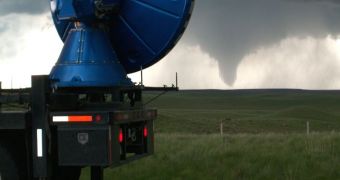An international team of researchers is currently getting ready to hit the road again this spring, as part of the VORTEX2 project. The group features more than 100 scientists, and as many as 40 support vehicles, and its main goal is analyzing tornadoes, how they form, and methods of predicting when and where they will hit. This is the second year the project is carried out, and its final season will begin on May 1, and last until June 15.
This is undoubtedly the most ambitious effort of its kind, as well as the most complex. The researchers involved benefit from the latest in tracking and analysis technologies, with all equipments mounted atop vehicles that can be readily deployed to wherever tornadoes form. The Verification of the Origins of Rotation in Tornadoes (VORTEX2) experiment is being funded and supported by the US National Oceanic and Atmospheric Administration (NOAA), as well as by the US National Science Foundation (NSF). According to the science team conducting the study, the most basic questions related to tornado formation are also the most difficult to answer.
Some of the most interesting mysteries that could be solved in the new effort include why, when and how tornadoes form, why some are more violent and long-lived than others, and what their internal structure is. Additionally, the investigators could learn more about the strength of winds near the ground level, as well as the precise mechanisms the air structures employ in producing damage. Based on such observations, the study scientists hope to be able to derive better forecast methods, for providing disaster-prone areas with more warning time before tornadoes strike.
“Current warnings have only a 13-minute average lead time, and a 70 percent false alarm rate. Can we issue reliable warnings as much as 30, 45 or even 60 minutes ahead of tornado touchdown?” asks the program director of the NSF Division of Atmospheric and Geospace Sciences, Brad Smull. The group includes scientists from the United Kingdom, Canada, Germany, Australia and The Netherlands. All experts come from about 12 universities, in addition to several governmental and private agencies. The lead scientist on VORTEX2 is expert Josh Wurman, from the Boulder, Colorado-based Severe Weather Research (CSWR).

 14 DAY TRIAL //
14 DAY TRIAL //